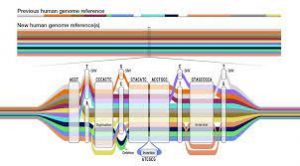Pangenome Reference Map:

A new study has been published in the Nature journal describing a Pangenome Reference Map, built using genomes from 47 anonymous individuals (19 men and 28 women), mainly from Africa but also from the Caribbean, Americas, East Asia, and Europe.
- A reference genome or reference map is like a standard map that scientists use when they sequence and study new genomes.
- It serves as a guide to compare and understand the differences between the newly sequenced genome and the reference genome.
- The first reference genome created in 2001 was a significant scientific achievement.
- It helped scientists discover disease-related genes, understand genetic aspects of diseases like cancer, and develop new diagnostic tests.
- However, it had limitations and wasn’t perfect
- The pangenome, unlike the previous linear reference genome, is represented as a graph.
- Each chromosome in the pangenome can be imagined as a bamboo stem with nodes.
- These nodes represent stretches of sequences that are similar among all 47 individuals. The internodes between the nodes vary in length and represent genetic variations among individuals from different ancestries.
- To create complete and continuous maps of the chromosomes in the pangenome project, researchers used a technology called long-read DNA sequencing, creating complete and continuous chromosome maps by producing accurate, long DNA strands.




